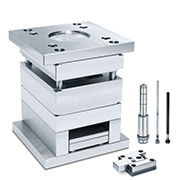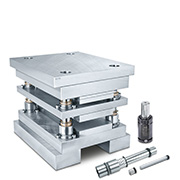Requirements for a tool holder
Concentricity
To ensure high dimensional accuracy, central rotation of the clamped tool to the axis of the tool holder is essential. This prevents contact breakage between the material and the tool, which would lead to repeated impact on the tool and would subsequently cause micro breaks on the cutting edge of the tool.
Balance quality
A finely balanced holder is crucial for the spindle to run smoothly. In combination with the right tool, this ensures better workpiece surfaces, maximum tool life and longer spindle service life.
Radial stiffness
During machining, the milling cutter absorbs forces that transfer to the tool holder. To absorb these forces, it is especially important that the holder has a high radial stiffness . If this criteria is met, large infeeds and high speeds can be realised.
Repeatability
Every time the tool is changed, there is a risk of deviating from the original set point value in the axial positioning of the tool holder. That is why it is all the more important to reproduce the predefined value again with every tool change. This is an essential factor in achieving high workpiece precision .

To sum it up the interface between the machine and the tool is partly responsible for reaching long service lives and achieving the full performance potential of cutting tools in modern machine tools. What’s more, milling results with high dimensional accuracy and best surface quality are only achieved by the optimum combination of tool, workpiece, tool clamping equipment and machine tool.
Other important criteria
Interfering contour
Deep cavities and complex contours – these are hurdles that are often difficult to overcome in the machining of cavities in mould halves. The interfering contour of the tool holder plays a major role here. A low interfering contour allows the use of shorter tools. The result:
- Higher cutting values
- Better surface qualities
- Longer service life
Projection length
Another point in manufacturing deep cavities is the projection length.
This is usually titled with dimension ‘A’ and is responsible for the tool reaching all the way down into the cavity. Thanks to our standard range of tool holders and the possibility of other projection lengths on request, Meusburger is the right choice.

Stability and damping
If high surface qualities are required during finish milling, stability and the damping properties of the tool holder play a major role. If the construction is not designed for the application or if a low-quality material is used for the manufacturing of the tool holder there will be significant effects on the results achieved.
Great savings potential due to the reduction of the eroding processes:
- The surface is milled to gloss by hard milling so that only partial areas nearby still need to be eroded.
- No subsequent eroding and polishing is necessary.
Maximum process reliability
The price for a finished mould half including cavity can quickly become expensive, and is significantly above the average market price of workpieces in conventional contract manufacturing, which makes it it even more important that no errors occur during production.
- Process reliability requirements for high precision and qualitymust be strictly observed in mould and die making.
Here you can find the matching tool holders






 © 2024 by Meusburger Georg GmbH & Co KG | All rights reserved
© 2024 by Meusburger Georg GmbH & Co KG | All rights reserved





 Česká republika [CS]
Česká republika [CS]
 Danmark [DA]
Danmark [DA]
 Deutschland [DE]
Deutschland [DE]
 España [ES]
España [ES]
 France [FR]
France [FR]
 India [EN]
India [EN]
 Italia [IT]
Italia [IT]
 Magyarország [HU]
Magyarország [HU]
 México [ES]
México [ES]
 Nederland [NL]
Nederland [NL]
 Österreich [DE]
Österreich [DE]
 Polska [PL]
Polska [PL]
 Portugal [PT]
Portugal [PT]
 România [RO]
România [RO]
 Schweiz [DE]
Schweiz [DE]
 Slovenija [SL]
Slovenija [SL]
 Srbija [SR]
Srbija [SR]
 Suomi [FI]
Suomi [FI]
 Sverige [SV]
Sverige [SV]
 Türkiye [TR]
Türkiye [TR]
 United Kingdom [EN]
United Kingdom [EN]
 USA [EN]
USA [EN]
 Ελλάδα [EL]
Ελλάδα [EL]
 България [BG]
България [BG]
 Росси́я [RU]
Росси́я [RU]
 华 [ZH]
华 [ZH]